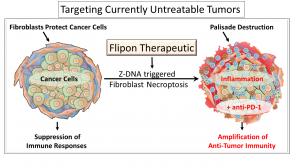
Flipon therapeutics: a Novel Modality for Targeting Treatment Resistant Cancers
Flipon therapeutics induce fibroblast cell death in inflamed tumors to enhance anti-tumor immune responses but spare normal cells.
While immune cell-point blocking antibodies have been a breakthrough therapy recognized by a Nobel prize award, not everyone responds and not all responders have long-term survival. A novel mechanism for improving outcomes has been described in a paper just published online in the Journal of Immunotherapy of Cancer. Induction of Z-DNA in the tumor stroma by an orally available small molecule amplifies the immune response against tumors by causing inflammatory cell death of fibroblasts that the tumor programs to fuel its survival.
Full Text
In a paper appearing online in the Journal of Immunotherapy of Cancer, today, a new way to kill hard to treat cancers is described by authors Alan Herbert from InsideOutBio and Sid Balachandran from Fox Chase Cancer Center.
The approach exploits Z-DNA that activates a highly inflammatory form of cell death in tumor fibroblasts, as shown in a recently published Nature from the two teams lead by the authors. The strategy differs from others targeting tumors.
First, it is not dependent on a particular DNA mutation that is driving tumor growth. Second, it relies on a pathway not expressed in normal cells. Consequently, it has potential application to a broad range of tumors and it less likely to be toxic to the body.
The drug used in the Nature paper is already in clinic, but has shown limited effectiveness as a single agent. It was not previously realized that it could cause right-handed DNA to flip to left-handed DNA. The flip is sensed by a protein called ZBP1 that is induced by interferon during the course of an anti-viral response. ZBP1 induces inflammatory cell death. Unlike other DNA sensors like the STING and TLR9 proteins that are targeted by therapeutics in clinical trial, ZBP1 is not expressed in normal tissue. Rather than inducing an inflammatory response in normal cells like TLR9 and STING do, ZBP1 amplifies the response after it is initiated. Targeting ZBP1 is therefore less likely to cause collateral damage to normal tissues than STING of TLR9 activators.
The ZBP1 activating drug destroys the fibroblasts supporting the tumor growth. By doing so, the drug enhances the effectiveness of immunotherapy using the checkpoint blocking antibody targeted at PD-1. The drug is a member of the curaxin family and was introduced to clinic for another reason. The compound has proven safe in Phase I trials but still requires further research to confirm its clinical use in conjunction with anti-PD1 provides a benefit in the treatment of cancers.
The Journal of Immunotherapy of Cancer paper examines why cancer associated fibroblasts are susceptible to the ZBP1 activating drug. Fibroblast proliferation is a hallmark of some tumor types. The fibroblast support tumor growth through a number of mechanisms that varies by the type of fibroblast the tumor induces. One class of fibroblast forms a palisade to encapsulate the tumor, preventing the immune system from attacking the cancer cells. Another class of fibroblast is inflammatory and is used by tumors to turn-off immune responses against the tumor. It is this class of fibroblast that expresses ZBP1 and is vulnerable to the induction of Z-DNA by the curaxin CBL0137.
Dr Herbert of InsideOutBio says “Flipon therapeutics are an exciting new class of drugs for inducing immune responses against tumors.”
Z-DNA is formed in normal cells by sequences called flipons that under physiological conditions can reversibly flip to the left-handed conformation. The structure was discovered by accident in the first ever synthetic crystal ever solved by X-ray crystallography. Other classes of flipons exist and are also highly likely to play important roles in biology.
Flipons are highly dynamic structures that have been hard to study as it is challenging to determine their exact conformation inside cells. Dr Herbert says that “It is similar to other highly dynamic systems in physics where you can only find the flipon conformation by making a direct measurement, but only if the act of measurement does not bias the result.”
InsideOutBio is an early-stage privately funded biotech company developing therapeutics for the treatment of cancer.
Alan Herbert
InsideOutBio, Inc
+1 6175840360
email us here
EIN Presswire does not exercise editorial control over third-party content provided, uploaded, published, or distributed by users of EIN Presswire. We are a distributor, not a publisher, of 3rd party content. Such content may contain the views, opinions, statements, offers, and other material of the respective users, suppliers, participants, or authors.


